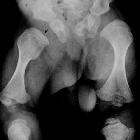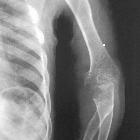spondyloepiphyseal dysplasia


Preschooler
with short stature. AP radiograph of the lumbar spine (left) shows delayed ossification of the femoral heads and delayed ossification of the pubic bones along with progressive narrowing of the distance between the pedicles descending through the lumbar spine (interpediculate narrowing). Lateral radiograph of the lumbar spine (right) shows the vertebral bodies to have anterior wedging and a pear shape leading to some kyphosis.The diagnosis was spondyloepiphyseal dysplasia.
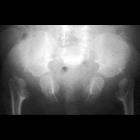
Preschooler
with short stature. AP radiograph of the pelvis shows delayed ossification of the femoral heads, with multiple femoral head ossification centers present along with delayed ossification of the pubic bones.The diagnosis was spondyloepiphyseal dysplasia.

Toddler with
an abnormal gait. AP radiograph of the pelvis shows delayed development of the femoral epiphyses bilaterally and overall there is flattening of the femoral heads. The diagnosis was spondyloepiphyseal dysplasia.
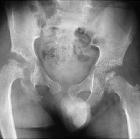
Spondyloepiphyseal
dysplasia • Spondyloepiphyseal dysplasia - Ganzer Fall bei Radiopaedia
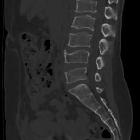
Spondyloepiphyseal
dysplasia • Spondyloepiphyseal dysplasia congenita - Ganzer Fall bei Radiopaedia

Spondyloepiphysäre
Dysplasie mit Coxa vara congenita beidseits und ovoider Konfiguration der Wirbelkörper mit Hyperlordose.
Spondyloepiphyseal dysplasia is a form of skeletal dysplasia mainly involving the spine and proximal epiphyses.
Clinical presentation
- short neck
- short trunk with protruding abdomen
- normal IQ
- spine
- atlanto-axial instability
- craniovertebral junction stenosis
- platyspondyly
- limbs
- mostly in shoulder, hip and knee: abnormal, underdeveloped proximal epiphysis
- short proximal limbs with normal size hands and feet
- scoliosis exaggerated lumbar lordosis
- coxa vara and waddling gate
Pathology
Two forms have been described:
- autosomal dominant with variable phenotypic expression
- abnormalities present at birth, short limbs (proximal and mid), normal size hands and feet
- due to abnormal synthesis of type 2 collagen
- x-linked recessive
- normal appearance at birth, short trunk becomes apparent in adolescence or adulthood
Associations
- myopia
- retinal hemorrhage
- hearing loss
- nephrotic syndrome
Complications
Radiographic features
Plain radiograph
- first test to survey the abnormalities
- platyspondyly
- bulbous and pear shaped vertebrae in congenita
- heaped up vertebrae in tarda
- vertebral hypoplasia
- femoral head flattening and late epiphyseal development
- large and dolichocephalic skull
- metaphyseal widening with rhizomelic shortening
- odontoid process hypoplasia
- absent calcaneal and knee epiphysis at birth
Treatment and prognosis
Treatment is supportive based on skeletal abnormalities. Normal life span is expected.
Siehe auch:
- Platyspondylie
- Kniest-Syndrom
- Pseudoachondroplasie
- Spondylometaphysäre Dysplasie
- Kongenitale Spondyloepiphysäre Dysplasie
- Spondyloepimetaphysäre Dysplasie
- Chondrodysplasie
- Spondyloepiphysäre Dysplasie Tarda (SEDT)
und weiter:

 Assoziationen und Differentialdiagnosen zu Spondyloepiphysäre Dysplasie:
Assoziationen und Differentialdiagnosen zu Spondyloepiphysäre Dysplasie:

